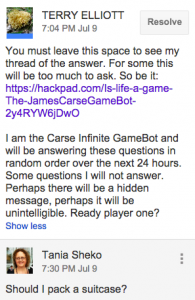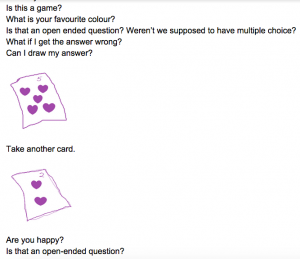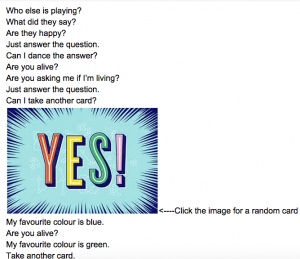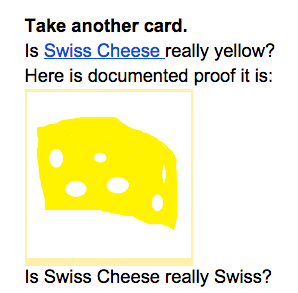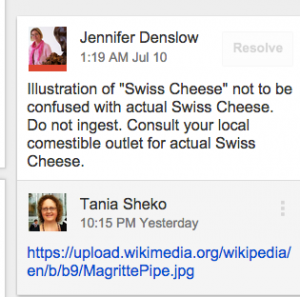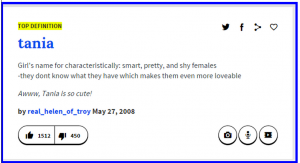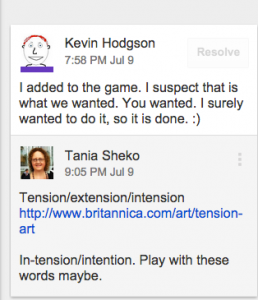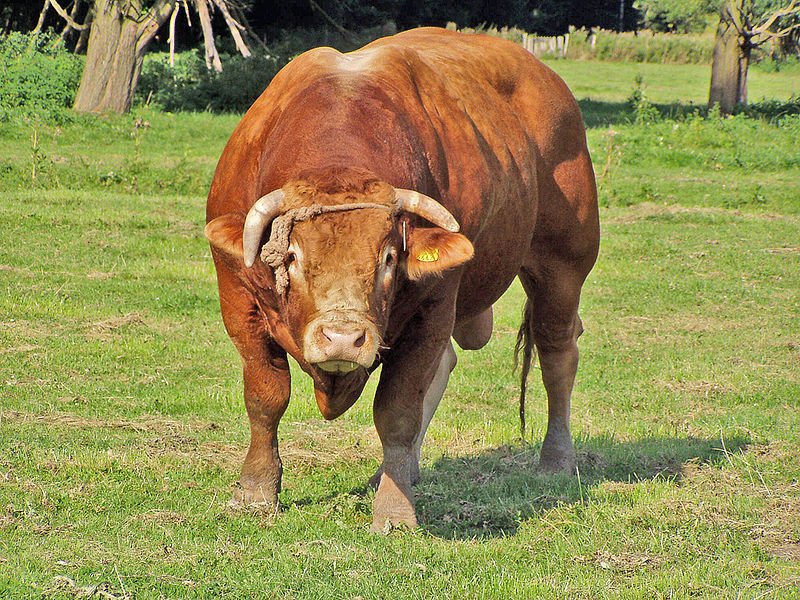As Terry posted in his blog, one thing led to another and it happened very quickly. Click on the larger image to see how it started. Terry explains it all.

This is Terry Elliott‘s annotation of the interaction between a few of us on Twitter. Yes, an annotation, that’s what I said.
I’ve written it out in linear fashion in case it’s difficult to read from this image.
And very soon Kevin Hodgson was in:

and then Terry played his hand

and back to Kevin

and Terry

Kevin again

Sometimes the comments section of a blog is vital to further annotation. In this case definitely. So following this series of remixes in Kevin’s post, Terry said the following:
What you have documented is connected learning and what Nick Sousanis refers to as unflattening. The messification of the world by increasing “parallax”. My whole argument in the original comic (and I do think of it as a comic) was that reciprocation was one of the requisite initial conditions for any of the connected learning principles and values. What happened yesterday was proof in practice. What I especially liked was that the rising complexity came from the initial conditions of reciprocity just like chaos theory tells us it does. Our web pages are flat but world they live in is multidimensional across time. Or as Sousanis says, upward and downwards not just north,south,east,and west. We’re not in Flatland anymore, Kevin.
Kevin answered with a summary of what he was trying to do, some reflection and a question:
In the post, I tried to purposefully leave out context and let the visual happen. I imagine some will say, “Say, Huh?” when they see it and wonder about the ping-pong effect. I had hoped others might join in but maybe the pace of the shuttling back and forth between media intimidated others. Or maybe it was Sunday and the folks were offline, unplugged. Or maybe they did not have the context for engaging in a media practice that surfaces connected learning. Surely, it was messification.
I’d like to squabble a bit about whether your initial image is a comic or not. It seems more flowcharty to me. But your push to have it viewed as a comic is what had me do the first iteration, in the comic maker. Looking at your first piece, it seems more of a flowchart, pushing things along. But when you called it a “comic,” I looked for panels … and gutters (see later joke) … and shout-out balloons … and characters … but I wonder if we need all that? How defined must our definitions of comics be?
Why did you call it a comic?
Curiouser and curiouser …
Terry again:
Panels, page, comic grammar (albeit spiral with numbers and arrows to help show movement), tweets as dialogue callouts, and a narrative with lots of characters. I think we can call a tweet an identity with a speech bubble without much of a stretch. And the rhetoric is visual not paragraphs although it gets paragraphy at the end. And the idea is, like Sousanis often shows an overall visual metaphor that supports the ideas in the panel–in this case a spiral.
and Kevin
Ok … I get your thinking …. working in a spiral … strike!
I wanted to play but didn’t know how. Terry and Kevin told me they used Snagit but I discovered that it cost quite a bit, and told them so in the following comment:
You two are brilliant. And this is great – the comic battle which happened so fast and now the articulation in the comments section. The reason I didn’t join in is because I’m not as adept at the technical side. Lots of ideas but need time to learn new making skills. Wasn’t prepared to pay $68 for Snagit. I think if my technical/making skills were improved I’d be able to capture the concepts that fly around in my head. Thank you for being brilliant!
In the next couple of comments Terry and Kevin expressed their commitment to inclusiveness in online courses:
This is where danger can creep in … leaving people out who want an entry way in but can’t find the door … Terry and I were building on past experiences via CLMOOC, Rhizowhatever, and more … and could riff … but were others feeling invited in? I know his initial invite was inclusive .. but once I responded, did the world tilt in only one direction?
No need for real answers to those questions … but this is what sits at the back of my mind (it’s a crowded place some days)
Thanks for taking the time to join the conversation here
Kevin
The only way is to help Tania play the game. The repertoire is not that extensive to get in the game. I think the attitude of play is the one that gets folks hung up. I felt very bad to exclude anyone. No like. Want more messiness in the mix. Want more mix. Gotta get Tania into the game.
And my reply
Ha ha! I will not be defeated by lack of technology. I have 2 and a half offerings. One is a sauce (reduction).
I did a poor version of blackout poetry using a printed copy of one of the remixes. Considering it was late on a school night and the lights interfered with the ipad photo of the printout, it’s surprising anyone can make out anything. Still, I thought, if technology isn’t working for me, I’ll just move across to another possibility.

Then I had a crazy idea: I asked my son (music student) to take a look at the remixed content and, based on the feeling he got from the look of it all, compose something quickly. He (Maxim) said:
What – now?
And I’m like: Oh yes, just something quick, whatever inspires you after looking at these comics. A kind of musical paragraph. And he did. Within 20 minutes I could share his Soundcloud link to a midi version (which he said might suit the comic style more) and the version with Sibelius sounds. If you look at that one you can see the comments Terry and Kevin have made which are visible in the music itself – very cool.

At this point I went to bed. It was late but I had to force myself to sleep because the creative exchange was so invigorating. In the morning I saw Terry’s remix of Maxim’s audio file.
Terry tweeted it out, saying: Wanted more pinbally busy-ness so I layered maxim soundtracks n2 Popcornmaker–remix?
Well, guess who couldn’t resist the remix? Here’s Kevin’s version, rich with imagery: For Maxim it was a new experience because he assumed music he whipped up would be of no value, and there it was, being listened to and commented on. But wait, there’s more! I also shared the score which was remixed immediately!

The river does not run dry for some people! This could go on and on. In fact, when I tried to explain the whole thing to friends I kept starting somewhere and then saying – no, I’ve got to go back a bit – and then kept going back and back through the rabbit hole. Backwards through the rabbit hole like pressing rewind. Exhilarating. I hope that this documentation is not too confusing, and that it has captured some of that outpouring of creative makes and remixes, that joy which comes from adding another layer, playfully hacking and not knowing when to stop.























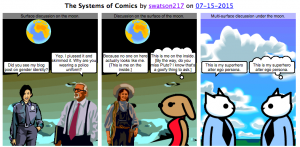



![[16:25] fallen](https://farm4.staticflickr.com/3530/4076320046_87decceee8_n.jpg)
